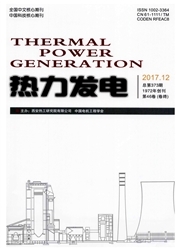

 中文摘要:
中文摘要:
对某660MW机组燃煤锅炉静电除尘器(ESP)前、后颗粒物和湿法石灰石一石膏脱硫装置(WFGD)后颗粒物分别进行了现场取样分析,研究了燃用2种煤时机组的PM2.5生成特性,并分析了ESP及WFGD对PM2.5粒径颗粒等不同排放特性的影响。结果表明:该锅炉燃用2种煤产生的细颗粒物PM2.5均呈双模态分布,且PM2.5与PM,。生成量与煤的灰分含量呈正相关关系;ESP对PM10、PM2.5和PM1.0的脱除效率分别为99.812%、99.711%和99.402%,对粒径0.1~1.0μm颗粒物的脱除效率低于其他粒径颗粒物;烟气经过装有气一气换热器(GGH)的WFGD后,粒径在1.0μm以上的颗粒物质量浓度下降约40%,而粒径〈1.0gm的颗粒物质量浓度升高约35%;脱硫浆液喷淋对颗粒物的洗涤作用会降低粒径〉1.0μm的颗粒物质量浓度;而超细颗粒物的团聚长大及脱硫浆液携带产生的石膏颗粒等则会导致〈1.0gm的颗粒物质量浓度有所升高。
 英文摘要:
英文摘要:
Particulate matter (PM) samplings were performed on a 660 MW coal-fired unit,at the inlet and outlet of electrostatic precipitator (ESP),and the outlet of limestone-gypsum wet flue gas desulfurization (WFGD) tower,to study the formation characteristics of PM2.5 when firing different types of coal. The in- fluences of the ESP and WFGD on emission characteristics of PM2.5 were investigated. A low pressure im- pactor (LPI) was applied to collect the PMs with different sizes,and the particle size distribution (PSD) and concentration of PMs were obtained via calculation. The results show that,the PMs produced from the combustion of the two tested coals are of bimodal size distribution. However, the PM yield differs from each other due to the different ash contents in coal. The ESP has a removal efficiency of 99. 812%, 99. 711% and 99. 402% for PM10, PM2.5 and PM1.0, respectively, with the lowest removal efficiency for PMs in the size range from 0.1 μm to 1 μm. When the flue gas passes through the WFGD tower and gas- gas heater (GGH) ,the concentration of PMs with size below 1.0μm increases by about 35% ,but the con- centration of PMs with size larger than 1.0 μm reduces by 40 %. Captured by the sprayed desulfurization slurry helps the concentration of PMs with size larger than 1.0 μm be reduced,while the coagulation of ul- trafine PMs and the gypsum slurry entrainment will cause an increase in concentration of the PMs with size less than 1.0 μm.
 同期刊论文项目
同期刊论文项目
 同项目期刊论文
同项目期刊论文
 期刊信息
期刊信息
